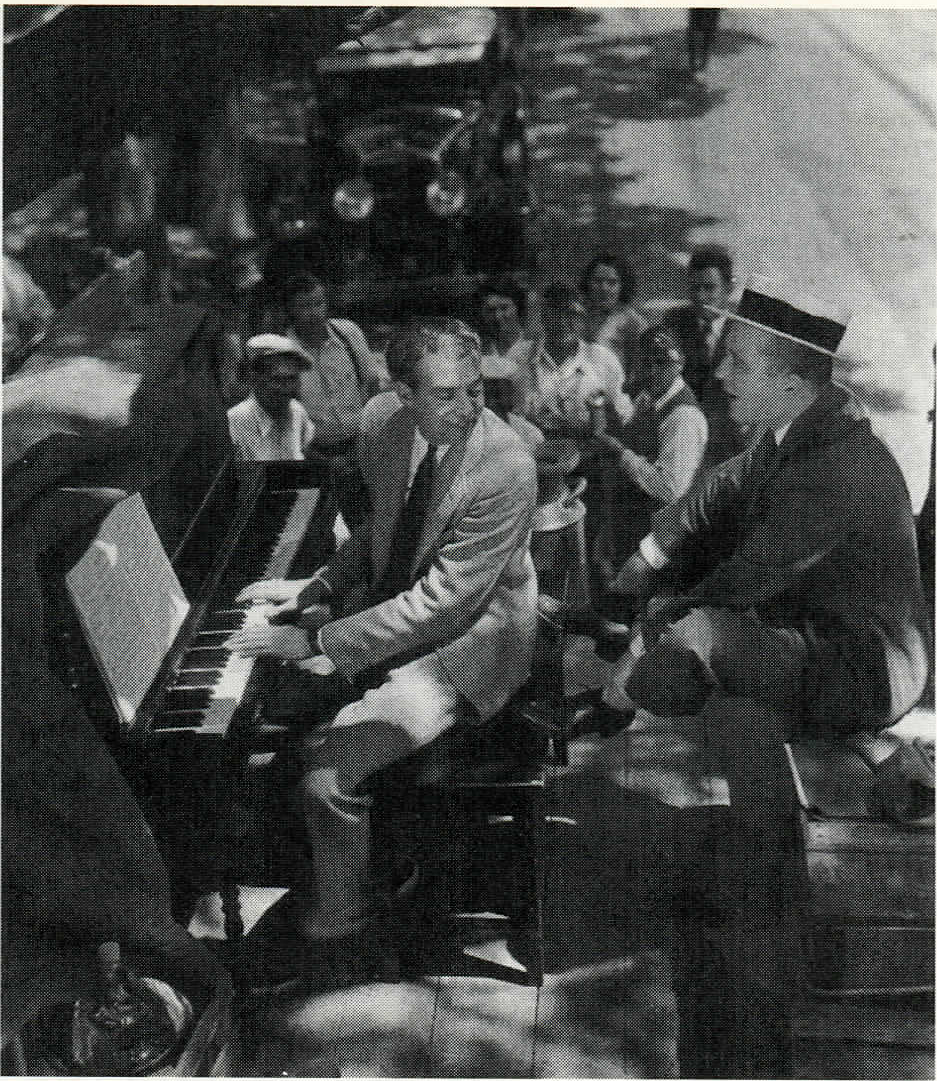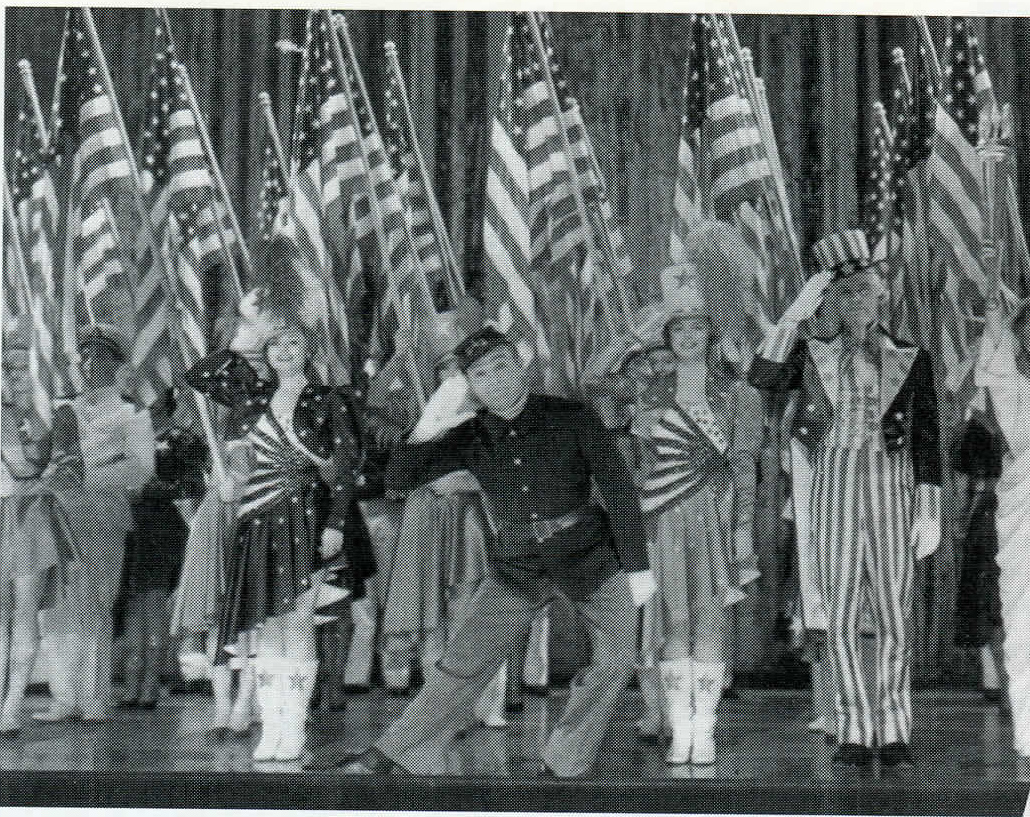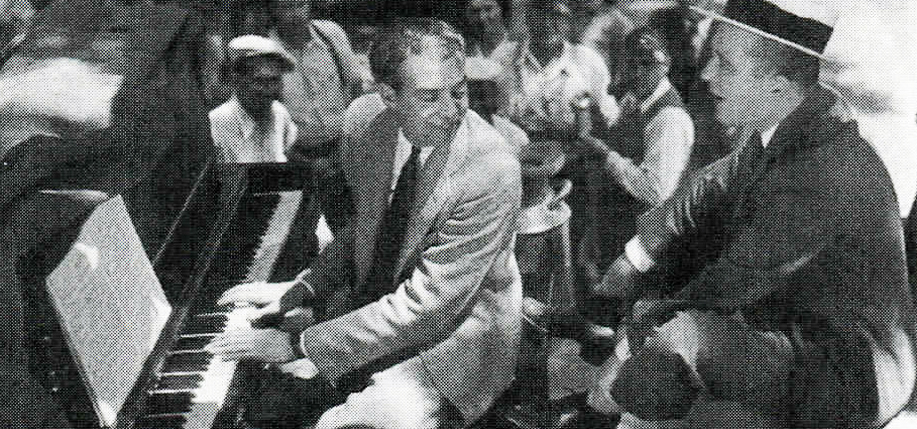The life of George M. Cohan, the greatest song and dance man of all time.
Not far off from his song’s boast, George Michael Cohan was born on July 3, 1878, according to his birth certificate, however his mother always claimed that he was born on the 4th, and as he proved again and again in his plays and songs, he remained “a real live nephew” of America’s Uncle Sam throughout his life.
Cohan loved three things fervently: show business, his family, and the United States of America. Carried on stage for the first time at the age of four months, he eventually became the most important person in American theater of his day. Between 1901 and 1940, he produced 80 Broadway plays and musical revues for which he wrote the plots, songs, and dialogue, and in which he frequently performed.
Cohan was born in Providence, Rhode Island, of Irish American parents. His grandparents simplified their Gaelic surname O’Caomhan to Keohane, then changed it to Cohan when they immigrated to the United States. They accented the final syllable and pronounced the name “Co-hán.”
George’s father, Jeremiah (Jerry) Cohan, was a quiet, gentle man with an abiding interest in show business. As a youngster he learned the sprightly clog steps familiar to Irish dancers and played both the harp and violin. He became a strolling player and developed an act, for which he composed the music and appeared in the minstrel shows popular in New England in the 1870s.
Jerry married a girl of Irish descent, Helen (Nellie) Costigan. A born mimic and a clever actress, Nellie stepped on stage for the first time without rehearsal to take the place vacated by an absent actress. From that time on, the young couple performed in vaudeville skits, variety shows, and plays, and their daughter Josephine (Josie) and son George soon joined them on stage.
Nellie never complained about the hardships of their barnstorming days. “They were good children and we put them to sleep in a dresser drawer or a trunk,” she told an interviewer. “It was worth it because my husband loved what he was doing so much that we all caught fire from him.”
Josie became a graceful dancer, singer, and actress, much in demand. Finding a place for “Georgie” required more patience and ingenuity. At the age of seven he played second violin in house orchestras, sold song books during intermissions, and wore a pseudo-cowboy outfit in “Daniel Boone on the Train,” a western melodrama. “I was second violin because I sat right next to the first violin,” Cohan explained in later years.
Jerry Cohan decided to form his own company and the family set out on a grueling tour, performing in farces and one-act comedies six times a day, six times a week, with day-long rehearsals on Sundays. As a result, young George attended school infrequently. In fact, the boy found time for only six weeks of formal education.
After six active years in show business, 13-year-old George found a part suited to his talents. He played the lead in Peck’s Bad Boy. Full of crude practical jokes and far-from-subtle humor, the play pleased audiences, especially audiences filled with young people.
Unfortunately, taking a punch at Peck’s “bad boy” in the person of young George M. Cohen became the ambition of every boy in America. Determined to hang on to his starring role, Cohan stood his ground and punched back. In later years Cohan said he fought his way out of every “show biz” alley on the touring circuit.
Not a born fighter to begin with, Cohan became one, and the cocky, belligerent attitude he learned as a youth became a stubborn facet of his personality.
The four Cohans continued to expand their act and perfect their songs, dances and comedy sketches. At an early age, George found out what made people laugh, and learned from experience how to pace, trim, and doctor a play.
He particularly admired the plays written by Dion Boucicault. “Boucicault tells the story quickly,” George pointed out. “He fills it with emotion, good plot twists, with a lot of laughter and some charming songs. And above all, thank God above all, Boucicault is fun.”
The Cohans continued their success at state and county fairs , but young George had his heart set on playing in New York. When his father decided to stick to the hinterland, George packed his bags and prepared to set out alone. Learning of his son’s decision, the kind-hearted Jerry took him aside. “Listen, son,” he said, “the next time you want to run away, you come and tell me about it, and we’ ll all run away together, the four of us.”
“Running away together,” the four Cohans headed for Broadway, but their adventure didn’t fulfill George’s dream. Arriving in New York City, they found their employer intended to break up the act. He offered Jerry, Nellie and Josie good spots on the variety bill, but insisted poor George must open each show, the worst spot on the bill, and attempt to warm up the audience.
George’s opening act attracted little attention and won almost no applause. He recited a dramatic poem, “The Bootblack’s Dream,” danced and sang his heart out, but early arrivals ignored the stage and continued reading their newspapers. Much humbled, George began writing songs and sketches for variety shows and burlesque teams.
The Four Cohans again took to the road in April Fool. Young George suggested a dozen ways to improve the weak play, but no one accepted his ideas. The frustration he suffered early in his career augmented his future resolve to act only in plays he wrote and produced himself.
About this time, Cohan created an eccentric dance step that revolutionized buck-and-wing dancing and it became his personal trademark. Other dancers soon copied his applause-winning step and it is still popular with modern “hoofers.” The applause the 17-year-old George received intensified his pride in his position as a “song-and-dance” man.
Give My Regards To Broadway
The Cohan luck changed in 1896. Employed at Hyde and Behrman’s Theater, one of the most sophisticated vaudeville houses in the New York area and in the entire United States, they were a huge success.
When an audience whistled and shouted, “Speech! Speech!” modest Jerry Cohan couldn’t believe his ears. Speechless, he waved his brash young son forward to the footlights. Bowing low, George gave the brief acknowledgment that became another trademark gesture: “Ladies and Gentlemen, my mother thanks you, my father thanks you, my sister thanks you, and I thank you.”

The family agreed George’s assertiveness and his never-ending quest for perfection played an important role in their new success. From that time forward, he managed the family team. Under his leadership, they became the top-salaried act in American vaudeville.
In July, 1899, George married Ethel Levey, a vivacious comedienne who sang, danced, and played the piano. George, who had just turned 21, and his 18-year-old bride honeymooned in California.
“Little Johnny Jones”
The turn of the century marked a happy time in American history, and the musical plays George Cohan wrote mirrored the country’s joyous vitality. The rising young playwright wrote musicals with rousing, cheerful, optimistic songs audiences could whistle and sing.
Drama critic Brooks Atkinson wrote: “Cohan’s songs, both words, and music, were sublimations of the mood of their day. They said what millions of people would have said if they had Cohan’s talent.”
In 1903 Cohan wrote Little Johnny Jones, a musical based on the life of Tod Sloan, a famous jockey. George played the lead and introduced early versions of his songs, “Yankee Doodle Dandy” and “Give My Regards to Broadway.”
Audiences loved the energetic show, but the critics panned it, so Cohan took it on the road. After strengthening the plot and refining the acting, he returned to Broadway with a hit. Little Johnny Jones made a great deal of money for Cohan and established him as an important theatrical figure.
Cohan also found a partner who took over the business end of his expanding empire. Cohan and Sam H. Harris enjoyed the same jokes, loved to attend baseball games, and shared an absorbing interest in the theater. In addition, Harris possessed an uncanny feeling for the type of production and kind of actor that appealed to audiences.
Although they had a daughter, Georgette, Ethel, and George Cohan separated and finally divorced in 1907. Four months after his divorce, George married Agnes Nolan, one of the chorus girls in Little Johnny Jones. His bride’s parents had 18 children and George loved large families. He soon moved his new in-laws into a larger home and bought a summer place for them across the street from another large Irish family, the Joseph P. Kennedy clan.
The Man Who Owned Broadway
With the help of his partner, Cohan became the reigning king of Broadway. The Harris-Cohan team built new theaters, renovated old ones, and continued staging successful productions. They earned the reputation, rare for the time, of being unfailingly fair and generous to actors. Harris became Cohan’s brother-in-law when he married Agnes’s sister Alice.

Because his beloved father belonged to the Friars, a club frequented by actors, George joined. In 1910 the Friars gave a banquet honoring George. As the unplanned climax to the evening’s entertainment, George and his father danced a waltz clog and sang the “Lively Bootblack” song of George’s youth. Jerry’s performance won the biggest hand of a gala evening.
The delightful Josie Cohan died in 1916, and her brother collapsed in a paroxysm of grief. A year later, Jerry died, and his loss was the greatest sorrow of George’s life. The two men were the best of friends and, in spite of his busy life, George never let a day go by without a visit with his father.
On April 6, 1917, the United States entered World War I. That evening Cohan shut himself in his study and wrote “Over There.” He often said he only set words to a bugle call, but Cohan’s composition served as the war’s most popular song.
By the end of the war, Cohan’s reputation as America’s greatest showman, actor, manager, playwright, composer, director, and financial wizard went uncontested, and he had already amassed a considerable fortune.
Most people agreed with actress Peggy Wood who said perfection was Cohan’s keyword. “He had the deepest and the most instinctive talent for the theater of anyone of his day.”
Generous to a fault, a soft touch for elderly or out-of-work actors, Cohan gave his money away freely. After his death, lawyers found the actor had given away much of his considerable fortune.
Although George and Agnes had two daughters and a son, Cohan found little time for family life, for rehearsals, performances, production duties, and all-night writing sessions consumed most of his time and energy.
Friends often found Cohan a complex and confusing man, and they complained about the contradictions of his personality. A woman who had known him for many years described him in these words: “Vain and violent-tempered, childish at times, sulky and temperamental, but a man with a heart and a soul, one who was easily hurt, and one who could be a great friend. There was a wistfulness always about George and there was never another Irishman born in the world who had his unfailing charm.”
Two Song-and-Dance Men Merge
From time to time, Hollywood studios toyed with the idea of making a film based on Cohan’s life in which he would dance and sing, but he ignored their overtures.
In 1941 Cohan finally approved a script and, although already terminally ill with cancer, he added voluminous notes and suggestions. The leading role was first offered to Fred Astaire, who turned it down. James Cagney, already a successful stage and motion picture star, also refused to consider the part, but Cagney finally agreed when Cohan himself made an appeal. During rehearsals, Cagney and his writers polished and rewrote portions of the script.

Cagney fitted the role perfectly. Like Cohan, Cagney was a dynamic and original “song-and-dance man” with years of stage experience. Even their physical characteristics were much alike. Cagney was two inches taller than Cohan’s height of 5’6″, but both men weighed about 150 pounds. Both had Irish features, belligerent chins, blue eyes, and freckles. In black-and-white, Cagney’s red hair was photographed blond and resembled Cohan’s. To capture Cohan’s unique dance style, Cagney rehearsed with Johnny Boyle, a dancer featured in The Cohan Review of 1916. “From Johnny, I learned the Cohan stiff-legged technique,” Cagney said later, “and his run up the side of the proscenium arch. It was hard, hard work!”‘
Since Cohan composed nearly 1,000 songs, producer Hal Wallis found it difficult to narrow down the selection and he was forced to omit some favorites. The songs chosen include “The Yankee Doodle Boy,” “Give My Regards to Broadway,” ”Harrigan,” and “You’re a Grand Old Flag.” The show closes with “Over There.”
Michael Curtiz directed the picture and Bill Cagney, Jimmy’s brother, served as associate producer. Jimmy’s sister, Jeanne, played Josie, Walter Huston and Rosemary de Camp were Cohan’s parents, and Joan Leslie appeared as the actor’s young wife.
Filming began on December 8, 1941, the day following the bombing of Pearl Harbor, and the picture, titled Yankee Doodle Dandy, scored an enormous success.
Reviews of the motion picture were enthusiastic. Time reflects the general opinion: “Smart, alert, hard-headed, Cagney is as typically American as Cohan himself…He has the Cohan trick of nodding and winking to express approval, the outthrust jaw, stiff-legged stride, bantam dance routines, side-of-the-mouth singing, and the air of likable conceit.”
Cagney received a “best actor” Academy Award in 1942 for his portrayal of George M. Cohan, and the film received three other Oscar awards and eight nominations. The New York City premiere of the movie, a war-bond benefit performance, netted $5 3/4 million for the U.S. Treasury.
Shortly before his death on November 5, 1942, Cohan saw a print of the film. He liked the movie version of his biography and said of Cagney’s performance, “My God, what an act to follow.” He sent a telegram thanking Cagney for his wonderful performance.
A great tribute from one song-and-dance man to a fellow artist, Yankee Doodle Dandy remained James Cagney’s favorite movie role. “It’s a good piece of entertainment,” he said. “It has solid laughs, deep warmth, great music.” The scene Cagney liked best was the final one featuring the actor descending the White House stairs after a talk with President Franklin D. Roosevelt.
One of the last things Cohan said reflected the way he felt about his life. Sitting by his bedside, his old friend Gene Buck commented, “No man ever did what you did in the theater. Doesn’t that make you proud as hell?”
Cohan roused himself, grinned, and repeated a phrase he often used, ”No complaints, kid. No complaints.” ♦
Editor’s Note: This article originally appeared in the July / August 1994 issue of Irish America. A statue dedicated to George M. Cohan was erected in Providence, Rhode Island where Cohann was born.



wow, great article. Makes me proud to be an American and an Irishman. That little island, this huge continent – what a match!
Bravo!
Happy happy days to you and thanks.
One of my favorite movies. It was a different time but a happier one. Life was simple and appreciated.
What a great story! George M. Cohan was a parishioner at St. Malachy’s Church on West 49th Street where my nephew and nieces just made their first communion and where my daughter has taught religion class.
Watching this movie tonight probably for the fifth time. Loved, loved the hoofing. Cagney and Joan Leslie! Loved the songs. Never been a flag waver myself, but adore this movie and every time I hear “Over There”, I tear up. Thank you TCM for replaying this movie!!
My husband and I just watched Yankee Doodle Dandy as we have every July 4th for the last several years on TCM. It’s always among our favorite movies. I was delighted to learn that James Cagney had similar characteristics to George Cohen both physically & in mannerisms. Further, he delivered Cohen’s unique dance steps & movements, which appeared effortless. How wonderful to learn this! Both performers were brilliant & uniquely talented. Every time we watch it, I fall in love with the movie again!
I loved this article!